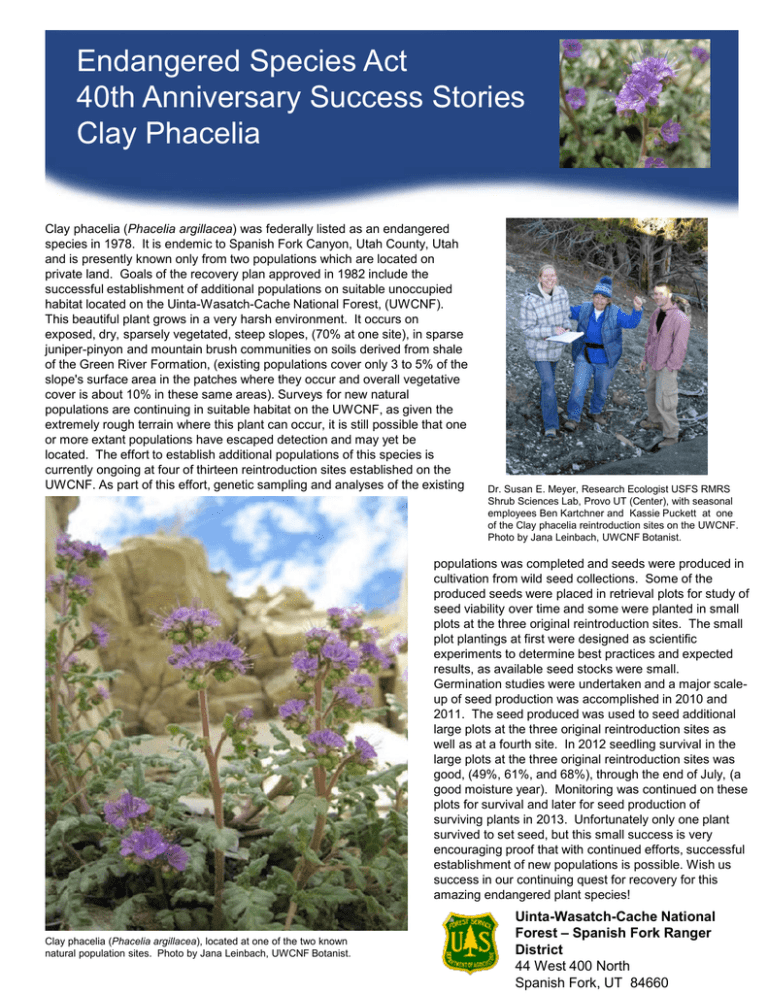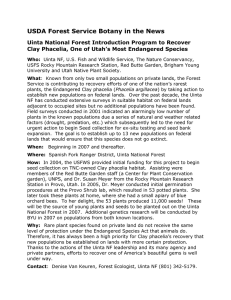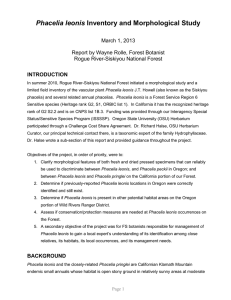Endangered Species Act Title text here 40th Anniversary Success Stories Clay Phacelia
advertisement

Endangered Species Act Title here 40thtext Anniversary Success Stories Clay Phacelia Clay phacelia (Phacelia argillacea) was federally listed as an endangered species in 1978. It is endemic to Spanish Fork Canyon, Utah County, Utah and is presently known only from two populations which are located on private land. Goals of the recovery plan approved in 1982 include the successful establishment of additional populations on suitable unoccupied habitat located on the Uinta-Wasatch-Cache National Forest, (UWCNF). This beautiful plant grows in a very harsh environment. It occurs on exposed, dry, sparsely vegetated, steep slopes, (70% at one site), in sparse juniper-pinyon and mountain brush communities on soils derived from shale of the Green River Formation, (existing populations cover only 3 to 5% of the slope's surface area in the patches where they occur and overall vegetative cover is about 10% in these same areas). Surveys for new natural populations are continuing in suitable habitat on the UWCNF, as given the extremely rough terrain where this plant can occur, it is still possible that one or more extant populations have escaped detection and may yet be located. The effort to establish additional populations of this species is currently ongoing at four of thirteen reintroduction sites established on the UWCNF. As part of this effort, genetic sampling and analyses of the existing Dr. Susan E. Meyer, Research Ecologist USFS RMRS Shrub Sciences Lab, Provo UT (Center), with seasonal employees Ben Kartchner and Kassie Puckett at one of the Clay phacelia reintroduction sites on the UWCNF. Photo by Jana Leinbach, UWCNF Botanist. populations was completed and seeds were produced in cultivation from wild seed collections. Some of the produced seeds were placed in retrieval plots for study of seed viability over time and some were planted in small plots at the three original reintroduction sites. The small plot plantings at first were designed as scientific experiments to determine best practices and expected results, as available seed stocks were small. Germination studies were undertaken and a major scaleup of seed production was accomplished in 2010 and 2011. The seed produced was used to seed additional large plots at the three original reintroduction sites as well as at a fourth site. In 2012 seedling survival in the large plots at the three original reintroduction sites was good, (49%, 61%, and 68%), through the end of July, (a good moisture year). Monitoring was continued on these plots for survival and later for seed production of surviving plants in 2013. Unfortunately only one plant survived to set seed, but this small success is very encouraging proof that with continued efforts, successful establishment of new populations is possible. Wish us success in our continuing quest for recovery for this amazing endangered plant species! Clay phacelia (Phacelia argillacea), located at one of the two known natural population sites. Photo by Jana Leinbach, UWCNF Botanist. Uinta-Wasatch-Cache National Forest – Spanish Fork Ranger District 44 West 400 North Spanish Fork, UT 84660






